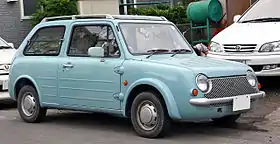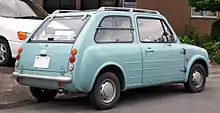Nissan Pao
The Nissan Pao is a retro-styled three-door hatchback manufactured by Nissan for model years 1989-1991, and originally marketed solely in Japan at their Nissan Cherry Stores.
| Nissan Pao | |
|---|---|
 Nissan Pao finished in Aqua Gray | |
| Overview | |
| Manufacturer | Nissan Motors (by Aichi Machine Industry)[1] |
| Production | 1989-1991 51,657 produced |
| Assembly | Oppama Plant, Yokosuka, Kanagawa, Japan |
| Designer |
|
| Body and chassis | |
| Related | |
| Powertrain | |
| Engine | 1.0 L MA10S I4 |
| Transmission | |
| Dimensions | |
| Wheelbase | 2300 mm (91 in) |
| Length | 3740 mm (147 in) |
| Width | 1570 mm (62 in) |
| Height | 1475 mm (58 in) |
| Curb weight | 720–760 kg (1590–1675 lb) |
First announced at the Tokyo Motor Show in October 1987, the Pao was available with or without a textile sun roof and was originally marketed without Nissan branding, by reservation only from January 15 through April 14, 1989. Orders were delivered on a first come-first served basis, with the production run of 51,657 selling out in 3 months.[2]
Because of its origins at Pike Factory, Nissan's special project group, the Pao — along with the Nissan Figaro, Be-1 and S-Cargo — are known as Nissan's "Pike cars."
In 2011, noted design critic Phil Patton, writing for the New York Times, called the Pike cars "the height of postmodernism"[3] and "unabashedly retro, promiscuously combining elements of the Citroën 2CV, Renault 4, Mini [and] Fiat 500."[3]
History

Part of Nissan's "Pike" series, it was designed as a retro fashionable city car in the mold of the Be-1. It included external door hinges like the original 1960s Austin Mini which had become fashionable in Japan, 'flap-up' windows like those of a Citroën 2CV, and a split rear tailgate of the first British hatchback car the Austin A40 Farina Countryman.[4][5] The Be-1, Pao, Figaro, and S-Cargo were attempts to create cars with designs as desirable as those of Panasonic, Sony, and other personal electronics products.[6]
The engine was the March/Micra's 1.0 L (987 cc) MA10S, coupled with a three-speed automatic transmission or a five-speed manual transmission, the manual being the more sought after. The engine produced 52 PS (38 kW; 51 hp) at 6,000 rpm and 7.6 kg⋅m (75 N⋅m; 55 lbf⋅ft) at 3,600 rpm.[7]
The chassis included rack and pinion steering, independent suspension with struts in front and 4-links and coil springs in back. Brakes were discs up front and drums in the rear. It has a clamshell hatch in back, meaning the glass section swings up and the bottom portion opens down to create a tailgate. The compact Pao requires just 4.4 m (14.4 ft) to turn and delivers up to 51 mpg (5.5 L/100 km) in the city and 79 mpg (3.4 L/100 km) at a steady 60 km/h (37 mph). The tires were of 155/SR12 format. The Pao was offered in four colors: Aqua Gray (#FJ-0), Olive Gray (#DJ-0), Ivory (#EJ-I) and Terracotta (#AJ-0).
The designs of the Pike cars (excepting the Figaro) are usually credited to Naoki Sakai, who also worked for Olympus, where he brought back "the brushed aluminium look". Sakai also helped design Toyota's later WiLL cars, which echo the Pike series.[6]
Specifications
Vehicle type number: Nissan E-PK10
Models:
- Pao w/5-speed manual transmission (PK10GF) or with 3-speed automatic (PK10GA)
- Pao canvas top w/ 5-speed manual transmission (PK10GFW) or with 3-speed automatic (PK10GAW)
- Dimensions and weight
- Length: 3,740 mm (147.2 in)
- Width: 1,570 mm (61.8 in)
- Height: 1,475 mm (58.1 in) - 1,480 mm (58.3 in)
- Wheelbase: 2,300 mm (90.6 in)
- Front/rear tread: 1,365 mm (53.7 in)1,355 mm (53.3 in)
- Ground clearance: 165 mm (6.5 in)
- Min. turning circle: 4.40 m (14.5 ft)
- Seating capacity: 5 people
- Vehicle weight: 720 kg (1,587.3 lb) - 760 kg (1,675.5 lb)
- Gross vehicle weight (kg): 995 kg (2,193.6 lb) - 1,035 kg (2,281.8 lb)
- Fuel consumption
- City: 5-speed 5.4 L/100 km (44 mpg‑US); automatic 6.9 L/100 km (34 mpg‑US)
- At steady 60 km/h (38 mph): 5-speed 3.4 L/100 km (69 mpg‑US); automatic 4.3 L/100 km (55 mpg‑US)
- Engine
- Type: MA10S
- Water-cooled inline-4 cylinder
- Cylinder bore and stroke: 68.0 x 68.0 mm
- Total cubic displacement: 987 cc
- Compression ratio: 9.5:1
- Output (net): 52 PS (38 kW; 51 hp) at 6000 rpm
- Largest torque (net): 75 N⋅m (55 lb⋅ft) at 3600 rpm
- 1-bbl carburettor
- Fuel and tank capacity: unleaded regular, 40 L (2,441 cu in)
- Interior colors
- Ivory (#EJ-I)
- Black (#EJ-I)
- Standard equipment
- Power steering
- Electromagnetic glass hatch release
- Height-adjustable driver's seat
- Intermittent wiper
- Tensionless ELR seat belts (front seats),
- Radio (AM/FM, tape deck, electronic tuner)
- 2 rear loudspeakers
References
- "Brief History | Corporate Profile | Aichi Machine Industry Co., Ltd". Aichikikai.co.jp. Archived from the original on 2010-10-18. Retrieved 2012-09-01.
- "日産:NISSAN MUSEUM" (in Japanese). Archived from the original on 2015-09-17. Retrieved 2012-11-16.
- Phil Patton (March 18, 2011). "Nissan's Cartoon Cars, Once So Hip". The New York Times.
- Lewin, Tony; Borroff, Ryan; Callum, Ian (2010). How to Design Cars Like a Pro. Motorbooks. p. 185.
- Copping, Richard (2006). VW Golf: Five Generations of Fun: The Full Story of the Volkswagen Golf. Veloce Publishing. p. 17.
- Phil, Patton (2011-03-18). "Nissan's Cartoon Cars, Once So Hip". The New York Times.
- 日産 パオ(1989年01月~1989年12月)1.0 キャンバストップ [Nissan Pao (1989.01-1989.12): 1.0 Canvas Top]. Car Sensor Lab Catalog (in Japanese). Recruit Co.